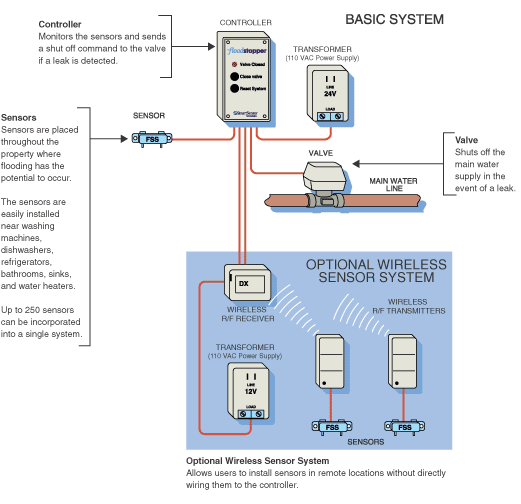FloodStopper leak detection system installation
The majority of our customers install the FloodStopper themselves. The FloodStopper system comes complete with an installation/operation manual. It is a fairly straight forward job for the average "home handyman/woman" or "do-it-yourselfer."
Alternatively, you can hire a general handyman, plumber, electrician, and/or security alarm system installer to assist you with all, or part of the installation. The cost for installation by a professional tradesperson will vary depending on the system you select, the ease of running wiring, your house design (finished/unfinished basement), and prevailing labor rates in your area. Professional installation extends the warranty period from one year to 5 years, so in addition to convenience and peace-of-mind, having your system professionally installed has its benefits.

The control panel is designed to conveniently mount over a standard electrical outlet box and is powered by a 24-volt plug-in transformer (plugs into standard 110 volt electrical outlet). The exclusive Honeywell valve is installed on your main water line and wired to the control panel. The sensors are mounted at the base of the walls throughout your home where water bearing appliances are located and may be hard-wired or remotely connected to the control panel.
Factors such as whether the basement is finished or unfinished, the number of floors, whether the walls line up from one floor to another, make a big difference in how long it takes to install the system. If the house is still under construction, the plumber can install the valve as he is roughing in the supply line. The electrician will find the rest of the system as easy to rough in as the doorbell system and thermostat. If the house is finished and has no crawlspace, it makes sense to use the wireless (remote) option. However, the valve and transformer will still need to be wired to the controller. This may limit where the controller is located. In a finished house with an unfinished basement, it is often possible to run the wires up the attic via the cold air return risers and then down through inside walls to the locations desired. Outside walls frequently have horizontal blocking, which would prevent wires from being fished down to floor level.
All wiring should be done to local code specifications. The FloodStopper system comes complete with a 24 volt transformer and accordingly, the complete system operates on only 24 volts. We generally recommend the use of standard 18 gauge (2 wire). This is the same wire typically used to install thermostats and doorbells. It can be purchased at any hardware or home supply store, or from us. The wiring can easily be concealed through crawlspaces, vents, attics, or voids in your walls, just like any other electrical wiring.
If you have an area of your home that you feel would be too difficult to run the wiring to, you can select one of our packages featuring a wireless receiver and transmitter. You can connect up to 25 water sensors to each transmitter, and 32 transmitters per receiver.
The valve should be mounted after the manual shutoff, pressure reduction valve, underground sprinklers, and any branch line serving fire suppression systems (sprinklers, etc.)
For more information, please see our frequently asked questions re: leak detector installation.



